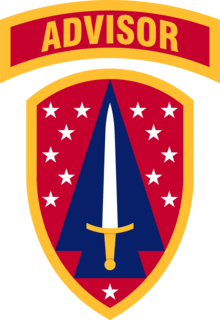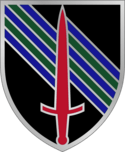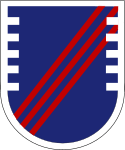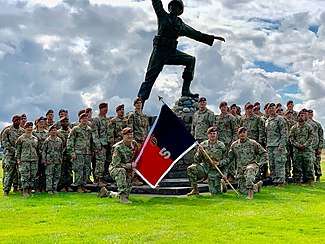5th Security Force Assistance Brigade
5th Security Force Assistance Brigade (5th SFAB) is a security force assistance brigade in the United States Army based at Joint Base Lewis-McChord, Washington. The unit (Vanguard Brigade)[1] stood-up on June 16, 2019 and will officially activate one year from that date.[2][3][4] As of December 15, 2019, the Brigade has hired 66% of its Advisors and continues to receive equipment, train personnel, and organize into distinct advisor teams. Following activation, the unit is scheduled to deploy to the Joint Readiness Training Center in November 2020 and deploy in support of a Global Combatant Commander in 2021.
| 5th Security Force Assistance Brigade | |
|---|---|
 The SFAB's shoulder sleeve insignia | |
| Founded | June 2019–present |
| Country | |
| Branch | |
| Type | Military education and training |
| Role | Train and advise foreign militaries |
| Garrison/HQ | Joint Base Lewis-McChord, Washington, U.S. |
| Color of berets | Brown |
| Commanders | |
| Current commander | COL Curtis D. Taylor |
| Command Sergeant Major | CSM Robert T. Craven |
| Insignia | |
| Distinctive unit insignia |  |
| Beret flash |  |

5th SFAB is a completely voluntary organization and volunteers typically serve a two to three year tour in the organization before returning to lead tactical formations in the conventional force. While assigned to 5th SFAB, Advisors are required to attend a 26-day Combat Advisor Training Course at Fort Benning, GA and are afforded the opportunity to attend other career-enhancing schools that promote the Advisor mission.[5] Graduates will have the requisite knowledge, skills, and attributes critical to the successful execution of Security Force Assistance (SFA) tasks. The eleven advisor attributes are disciplined, mature, sound judgment, initiative, cool under pressure, tolerance for ambiguity, open-minded, empathetic, situationally aware, patient, and morally straight.[6]
National Defense Strategy
The 2018 National Defense Strategy (NDS) describes a need for the United States to transition from counter-insurgency to long term strategic competition against powerful adversaries with near-peer capabilities. To achieve this transition, the strategy directs military forces to “expand the competitive space” and “strengthen alliances and attract new partners.” [7] Security Force Assistance Brigades are specifically designed and organized to achieve these two critical mandates in the NDS. Composed of 820 specially selected officers and non-commissioned officers who must undergo a rigorous screening process, the SFAB is manned and equipped to operate in small teams in the competitive spaces of the globe where this great power conflict is most intense. The SFAB’s mission is to train and advise conventional military forces in order to build long lasting trust among like-minded professional military forces and to establish the United States as the partner of choice in regions of the world that are vital to US strategy.[7]
5th SFAB organizational structure
5th SFAB is organized like a traditional Brigade Combat Team with 2 Infantry Battalions, 1 Cavalry Squadron, and a Fires, Engineer, and Logistics Battalion. These six battalions and the brigade staff are organized into 61 separate advisor teams that range in size from four to twelve personnel and are generally led by a post-command Captain and a Sergeant First Class.[8] Teams are organized to provide infantry, cavalry, artillery, engineer, or logistics training and support. With this broad spectrum of conventional capabilities, 5th SFAB is able to provide graduate-level training and advisory support to the most advanced military partners in the world. Advisors are selected into the Brigade at all levels from Corporal to Colonel based on their expertise in the conduct of large scale combat operations (LSCO) at the squad to division level. Advisors also must demonstrate a high level of physical fitness, stamina under pressure, and the ability to work well in small teams with limited guidance and contact with a higher headquarters.[9]
References
- 5th Security Force Assistance Brigade - SFAB
- "Army's newest brigade of combat advisers activated in Texas at Fort Hood". Stars and Stripes.
- Myers, Meghann (May 21, 2018). "These three posts will be home to the Army's next security force assistance brigades". Army Times. Retrieved December 18, 2019.
- U.S. Army Capt. William Leasure, 5th Security Force Assistance Brigade (28 February 2020) The 5th SFAB roars to life during Exercise Lethal Vanguard
- "CATC Welcome Letter". Joint Base Lewis-McChord. February 20, 2019.
- "5th Security Force Assistance Brigade". Joint Base Lewis-McChord.
- "Summary of the 2018 National Defense Strategy" (PDF). United States Department of Defense.
- "5th Security Force Assistance Brigade". Joint Base Lewis-McChord.
- "Security Force Assistance Brigade (SFAB)". goarmy.com.